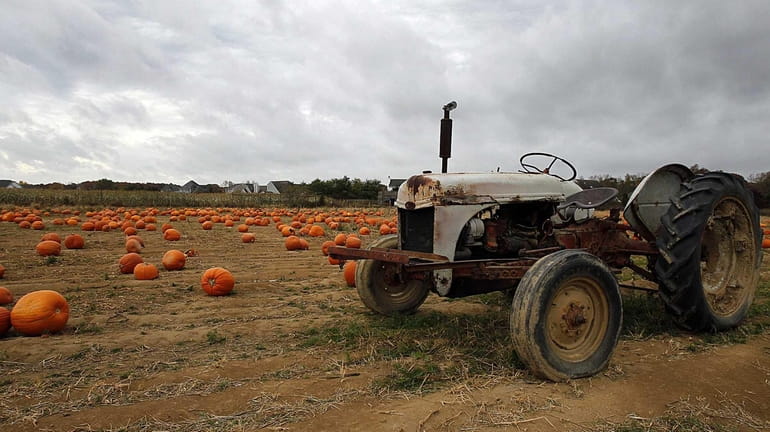East End farmers use mustard plants to cleanse soil after bumper pumpkin crop

Pumpkins, accompanied by an old tractor, sit in the field at Mays Farm in Wading River. (Nov.1, 2013) Credit: Joseph D. Sullivan
An increasing number of East End farmers are experimenting with a colorful way to recover from this year's bumper pumpkin crop: yellow mustard plants.
More planters have turned to the alternative as a cover crop in recent years as the acreage used for pumpkins has increased, from 638 acres in Suffolk in 2007 to up to 2,000 acres this year, according to state and Long Island Farm Bureau estimates.
"It's a biofumigant. It has the ability to depress certain fungus in the soil," explained Chris Kaplan-Walbrecht, who with his wife operates the Garden of Eve organic farm in Riverhead. "It's becoming to where people are really swearing by it," he said. "It's an alternative to using a fungicide or not using as much of it. That appeals to any type of farmer."
Local officials did not have estimates on the number of farmers engaging in the practice, but Steve Reiners, a professor of horticultural sciences at Cornell University in Ithaca, said the uptick reflects a national trend. "Typically, you use a very hot mustard. . . . When you chop it up and turn it into the ground, it releases a natural soil fumigant," a sulfur compound that works its way through the soil. "It's more effective in sandier soils like those on Long Island," he said.
Farmers on the North and South forks have marked the end of Halloween by grinding their unsold pumpkins into the soil, a practice that also helps avoid the potential danger of pumpkin rot and other diseases that can quickly spread through a field and kill vines, farmers said.
A few farm stands still sell pumpkins, but most farmers work hard to break them up and get them into the ground, where they can turn to compost and enrich the soil for next year."You want them to decompose. You don't want fungus to get into the soil," explained Joseph M. Gergela III, executive director of the Long Island Farm Bureau, who said Long Island had what should turn out to be a profitable year for most growers.
With pumpkin season past, Reiners said some farmers scatter mustard seed while the ground is frozen, letting seed work its way into cracks.
Kaplan-Walbrecht said the timing for planting can be tricky. Some farmers plant it in fall, while others plant in the spring. The longer it grows, the better it works to kill soil fungus, but it, too, has to be plowed into the ground before pumpkins grow to maturity.
Come spring, some of those pumpkin fields will look very different, with blazing patches of yellow replacing the green of cover crops or the orange of pumpkins, advocates say.
For farmers, the value is not in harvesting and selling the yellow mustard plants, but in helping protect the soil from disease that could devastate pumpkins next year.
Pumpkin boom
The acreage used for pumpkins has increased, from 638 acres in Suffolk in 2007, to up to 2,000 acres this year, according to state and Long Island Farm Bureau estimates.

Updated now Newsday travel writer Scott Vogel took the ferry over to Block Island for a weekend of fun.

Updated now Newsday travel writer Scott Vogel took the ferry over to Block Island for a weekend of fun.
